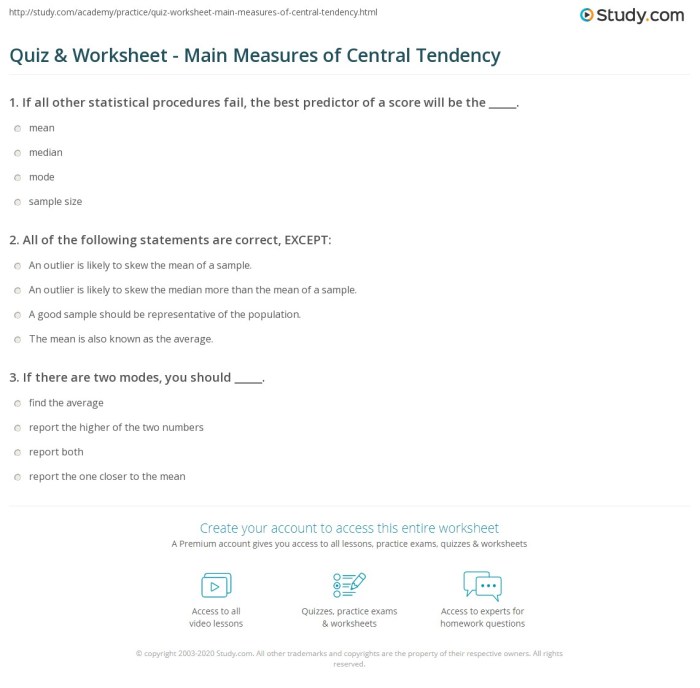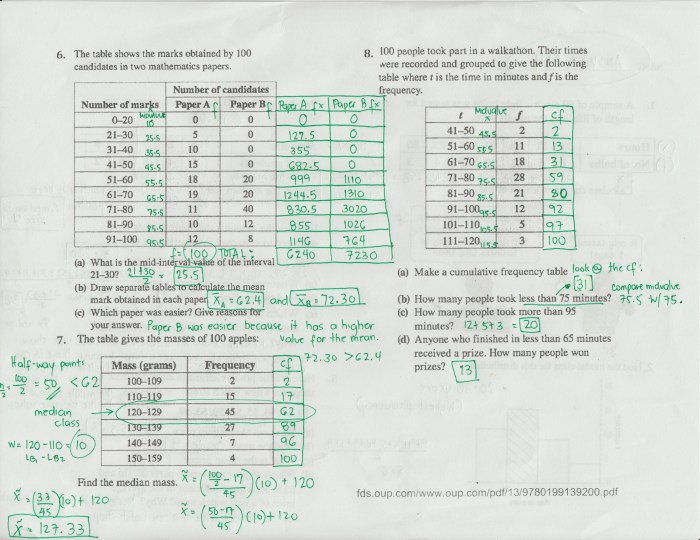Embark on a journey into the realm of measures of central tendency, where the mysteries of mean, median, and mode unravel. This comprehensive guide, “Measures of Central Tendency Worksheet Answers,” unravels the intricacies of these statistical concepts, empowering you with the knowledge to decipher data and make informed decisions.
Delve into the heart of this discourse, where we explore the nuances of each measure, uncovering their strengths and limitations. From calculating the mean to identifying the elusive mode, we navigate the statistical landscape with precision and clarity.
Measures of Central Tendency

Measures of central tendency are statistical measures that describe the “middle” or “average” value of a data set. They provide a concise summary of the data and are commonly used in descriptive statistics and data analysis.
Mean
The mean, also known as the average, is the sum of all values in a data set divided by the number of values. It is calculated by adding up all the numbers and dividing the sum by the total count.
Formula: Mean = (ΣX) / N
Advantages:
- Easy to calculate
- Sensitive to changes in data values
Disadvantages:
- Can be distorted by outliers (extreme values)
Median
The median is the middle value of a data set when assorted in numerical order. If there is an even number of values, the median is the average of the two middle values.
Steps to find the median:
- Arrange the data in numerical order.
- If the number of values is odd, the median is the middle value.
- If the number of values is even, the median is the average of the two middle values.
Significance:
- Not affected by outliers
- Provides a more representative value for skewed data
Mode
The mode is the value that occurs most frequently in a data set. A data set can have multiple modes or no mode at all.
How to identify the mode:
- Find the value that appears most often in the data set.
- If there is a tie, the data set has multiple modes.
Limitations:
- Not a reliable measure for small data sets
- Can be misleading if the data set has multiple modes
Comparing Measures of Central Tendency, Measures of central tendency worksheet answers
| Measure | Formula | Sensitivity to Outliers | Appropriate for Skewed Data |
|---|---|---|---|
| Mean | (ΣX) / N | Yes | No |
| Median | Middle value (numerical order) | No | Yes |
| Mode | Most frequent value | No | No |
Applications of Measures of Central Tendency
Measures of central tendency are widely used in various fields, including:
- Statistics:Summarizing and describing data sets
- Business:Analyzing sales, profits, and other financial metrics
- Healthcare:Tracking patient outcomes and identifying trends
- Education:Assessing student performance and identifying areas for improvement
Choosing the correct measure for a specific application is crucial to ensure accurate and meaningful analysis.
FAQ Section: Measures Of Central Tendency Worksheet Answers
What is the primary purpose of measures of central tendency?
Measures of central tendency provide a concise representation of a dataset by identifying its central value, facilitating comparisons and summarizing data.
How do I calculate the mean of a dataset?
To calculate the mean, add up all the values in the dataset and divide the sum by the total number of values.
What is the significance of the median?
The median represents the middle value of a dataset when arranged in ascending order, providing a measure of central tendency that is not affected by extreme values.

